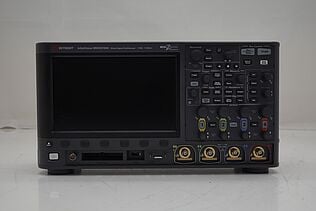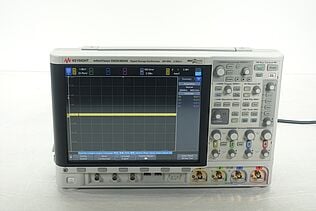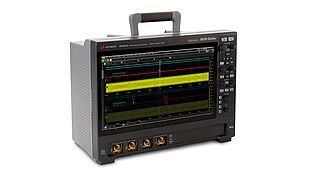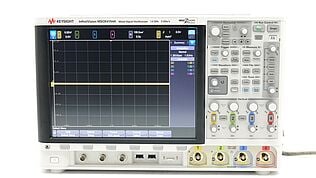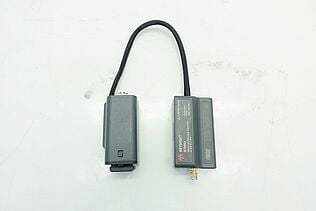- Introduction
- The Intriguing Concept of Resistance
- Resistance and Ohms Law
- Resistance Measurement: The Ohm
- Sub-Units and Multiples of Ohm
- Measuring Resistance with Instruments
- Using an Ohmmeter
- The Role of Oscilloscopes
- The Impact of Resistance on Signal Integrity
- Why Understanding Resistance Matters
- Factors Influencing Electrical Resistance
- Types of Resistors
- Resistance in Series and Parallel Circuits
- Effects of Resistance on Power Consumption
- Resistance and Joule's Law
- Implications for Circuit Design
- Conclusion
- Whenever You’re Ready, Here Are 5 Ways We Can Help You
- Popular Used Oscilloscopes
Did you know that the iconic lightbulb, symbolic of every great idea, wouldn't shine without resistance? To the untrained eye, the ubiquitous lightbulb is just a vessel of light, silently illuminating our surroundings. To an electrical engineer, it represents a marvel of electrical resistance.
This fundamental property of electrical circuits is at the heart of every electronic device, from the simple lightbulb to the most sophisticated supercomputer. Now, let's dive into the mystery of resistance, its measurement units, and why understanding it matters.
Buy Oscilloscopes at a Great Discount
The Intriguing Concept of Resistance
Resistance, in the realm of electricity, is a material's opposition to the flow of electric current. It stems from the interaction between the moving electrons, which constitute the current, and the atoms of the material they're traversing. The resulting resistance shapes the performance of the circuit by controlling how much current passes through. In the case of old-fashioned incandescent light bulbs, the loss of electrical current is dissipated in the form of heat and visible light.
Resistance and Ohms Law
Ohms Law, named after the German physicist Georg Simon Ohm, is a fundamental principle that defines the relationship between resistance, voltage (the electrical force), and current. Simply put, it states that:
- Voltage is equal to current times resistance (V=IR)
- Current is equal to voltage divided by resistance (I=V/R)
- Resistance is equal to voltage divided by current (R=V/I)
Understanding this law is essential for engineers, as it allows them to calculate and adjust the required resistance for a particular electrical application.
| Key Takeaway |
|---|
| Resistance, an inherent property governing the flow of electrical current, is a pivotal concept in electrical engineering. It affects everything from basic circuit design to advanced digital signal integrity. |
Resistance Measurement: The Ohm
The unit of measurement for electrical resistance is the ohm (Ω), named after the aforementioned Georg Ohm. This unit enables engineers to quantify the degree of resistance in a circuit.
Sub-Units and Multiples of Ohm
In real-world applications, the resistance can span a broad range, and so, for ease of notation, multiples and fractions of the Ohm are often used. Some common ones include:
- Milliohm (mΩ) = 1/1,000 of an ohm
- Kiloohm (kΩ) = 1,000 ohms
- Megaohm (MΩ) = 1,000,000 ohms
- Gigaohm (GΩ) = 1,000,000,000 ohms
This scaling allows for the precise representation and comparison of resistances across different contexts.

Measuring Resistance with Instruments
The primary tool for measuring resistance is the Ohmmeter, often integrated into a multimeter. However, oscilloscopes and other testing equipment are also used for more complex measurements.
Using an Ohmmeter
An Ohmmeter measures resistance by applying a small voltage across the test leads and measuring the current flowing through. The device then uses Ohm's Law to calculate the resistance.
The Role of Oscilloscopes
In the world of electrical engineering, oscilloscopes are invaluable tools. They allow engineers to visualize electrical signals, thus providing a dynamic picture of the circuit's performance. While they do not directly measure resistance, they can infer it by analyzing the changes in voltage and current over time.
The Impact of Resistance on Signal Integrity
Resistance plays a significant role in determining the signal quality in high-speed digital circuits. Higher resistance can lead to signal attenuation, distorting the transmitted data. Combined with capacitance and inductance, resistance forms a part of the impedance matching considerations that ensure clear and accurate signal transmission.

Why Understanding Resistance Matters
For electrical engineers, understanding and controlling resistance is crucial. Here's why:
- Component Protection: High resistance can lead to overheating and potentially damaging sensitive components.
- Energy Efficiency: The higher the resistance, the more energy is wasted as heat.
- Performance Tuning: Adjusting resistance allows for the fine-tuning of a circuit's performance.
The Impact of Resistance:
| Factor | High Resistance | Low Resistance |
| Current Flow | Decreased | Increased |
| Energy Wastage | Increased | Decreased |
| Potential for Overheating | High | Low |
| Circuit Performance | Tuned Down | Tuned Up |
Factors Influencing Electrical Resistance
Resistance isn't a static property but is influenced by several key factors, including:
- Material: Different materials offer varying degrees of opposition to current flow. For instance, copper and aluminium are often used as conductors due to their low resistance, while rubber and glass are insulators with high resistance.
- Cross-sectional area: A larger cross-sectional area allows more paths for the current to flow, thereby reducing the resistance.
- Length: The longer the electrical circuit, the higher the resistance, as the electrons have a longer path to traverse.
- Temperature: As temperature increases, so does resistance in most conductors. This happens because the atoms of the conductor vibrate more at higher temperatures, increasing the chances of collision with the electrons.
Types of Resistors
Resistors come in many forms and each serves a different purpose. Key types include:
- Fixed Resistors: These have a fixed value of resistance. They're commonly used to set the correct conditions in an electrical circuit.
- Variable Resistors (Rheostats): The resistance of these devices can be adjusted, making them useful for regulating current, like in a light dimmer.
- Thermistors: These are temperature-sensitive resistors. Their resistance varies significantly with temperature, making them ideal for temperature-sensing applications.
- Photoresistors (Light-dependent resistors): The resistance of these components decreases with increasing incident light intensity. They're commonly found in light-sensitive devices like night lights and outdoor lighting.
Resistance in Series and Parallel Circuits
In series circuits, total resistance (R_total) is simply the sum of individual resistances:
R_total = R1 + R2 + R3 + …
In parallel circuits, total resistance is found using the formula:
1/R_total = 1/R1 + 1/R2 + 1/R3 + ...
Understanding these rules allows engineers to design complex circuits and predict their behavior.
Effects of Resistance on Power Consumption
Power consumption is a critical parameter in the design and operation of any electrical and electronic system. Resistance plays a pivotal role in this aspect, impacting both the energy efficiency and the performance of the system.
Resistance and Joule's Law
One of the fundamental principles tying resistance to power is Joule's First Law. It states that the power dissipated in a resistor is proportional to the square of the current flowing through it (P = I²R) or the square of the voltage across it (P = V²/R). This means that the higher the resistance for a given current, the more power is dissipated as heat in the resistor
Implications for Circuit Design
Understanding Joule's Law and the effects of resistance on power consumption is crucial for electrical engineers. Here are a few reasons why:
- Energy Efficiency: When power is dissipated as heat in a resistor, it's wasted energy. By reducing resistance, engineers can increase the energy efficiency of a device, a key consideration in battery-operated devices and green technology.
- Thermal Management: Higher resistance leads to more heat generation, which can be a serious concern in electronic devices, causing components to fail or even damaging the device. By managing resistance, engineers can control the amount of heat generated and avoid thermal issues.
- Performance: In some devices, like electric heaters, resistance is intentionally increased to generate heat. Similarly, in lighting solutions like incandescent light bulbs, the light is produced by heating a high-resistance filament.
Therefore, resistance is not just a property to be studied; it's a parameter to be optimized according to the requirements of each specific application. By gaining a deeper understanding of resistance and its effects on power consumption, electrical engineers can design more effective and efficient electronic devices.
Conclusion
Resistance is an underappreciated parameter in the world of electronics. Its influence is felt everywhere, from the properties of the materials we use to the design of the circuits themselves. It helps us adjust the glow of a light bulb, keep our digital signals clean and clear, and even offers an explanation for superconductivity. Understanding and skillfully controlling resistance is a must for any electrical engineer.
But mastering resistance theory isn't enough on its own. You need the right tools to measure and analyze circuits, and to see if your designs work as planned. That's where Keysight's used equipment store comes in, with a range of top-tier, carefully calibrated test equipment including advanced oscilloscopes, multimeters, and more.
Whether you're working on high-speed digital circuits, or diving into superconductor research, Keysight gives you the tools you need to excel. Visit the Keysight used equipment store and equip yourself with the best tools in the industry.

Whenever You’re Ready, Here Are 5 Ways We Can Help You
- Browse our Premium Used Oscilloscopes.
- Call tech support US: +1 800 829-4444 Press #, then 2. Hours: 7 am – 5 pm MT, Mon– Fri
- Talk to our sales support team by clicking the icon (bottom right corner) on every offer page
- Create an account to get price alerts and access to exclusive waitlists
- Talk to your account manager about your specific needs

Subscribe to Get Our Latest News, Updates, and Articles.
Popular Used Oscilloscopes
Keysight Used Oscilloscopes offers a wide range of industry leading pre-owened oscilloscopes, ranging from older generation Agilent oscilloscopes to the newest Keysight oscilloscope models. So whether you are a fist time buyer, replacing a model like-for-like or looking for upgrade – we have something for you.
